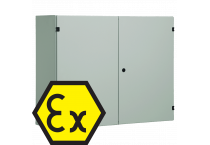Devices and Components for Explosion Hazard Zones EX
All kinds of equipment and elements, including systems, components, and electronic devices used in areas classified as explosion hazard zones must meet the requirements set out in the European directives 2014/34/EU (ATEX 114). They are confirmed by certificates indicating in which zones they can be used without the risk of ignition of flammable gases, vapors, mists, or dusts.
What are explosion hazard zones?
EX Zone is a space where a potentially explosive atmosphere is present. In other words, it is at risk of forming a mixture of air or another oxidizer with flammable substances in the appropriate concentration. This atmosphere, in case of accidental ignition, undergoes rapid combustion, leading to an explosion causing a pressure increase of at least 5 kPa.
Explosion hazard zones are designated in places where flammable gases, liquids and their vapors, mists, or dusts are present. Due to the factors that may lead to incidents, according to the ATEX directive, they are divided into 6 different types.
Is every EX zone equally dangerous?
Not all EX zones are equally at risk of uncontrolled explosions if an ignition source such as an electric, electrostatic, mechanical spark, or sudden hot air blast occurs. Therefore, for areas with gases or liquids, they are classified from 0 to 2.
Zone 0 explosion hazard is considered the most dangerous. It is a space, often inside pipelines, tanks, and containers, where the explosive atmosphere is present continuously for a long period.
Zone 1 explosion hazard is an area where the risk of an explosive atmosphere forming under normal working conditions is rare or occurs occasionally.
Zone 2 explosion hazard is characterized by the lowest risk, as the explosive atmosphere does not occur under normal working conditions, and if it does appear, it is only for a short time.
In addition, explosion hazard zones are also classified for dusts, powders, and fibers. In this case, they are divided into Zone 20, 21, and 22, where the time and circumstances of the explosive atmosphere occurrence are similar to those used for Zones 0, 1, and 2 for gases and liquids.
Explosion Protection and EX Zones
Each EX zone must be equipped only with devices specifically selected for it according to the applicable regulations. They should be designed according to ATEX standards, which require various protective measures to prevent the ignition of the explosive atmosphere.
These solutions primarily include special Ex-d enclosures, resistant to internal explosions, preventing them from escaping to the outside. They are equipped with flame-arresting conduits and thick walls.
Additionally, devices intended for explosion hazard zones also use intrinsic safety protections (Ex i), covering electrical circuits that do not generate sufficient energy for ignition even in the event of a short circuit or damage. Their protection level is further divided into three subcategories — ia, ib, ic. The first provides the highest level of protection and is intended for Zone 0 explosion hazard, while ic offers the least.
At DACPOL, you will find a wide range of components and devices for EX zones that meet ATEX and global standards such as IECEx. These include:
- lighting elements,
- distribution boards,
- wires,
- grounding devices,
- emergency power supplies,
- AC/DC power supplies,
- fans,
- heaters,
- light and sound signal devices.
Their selection not only allows you to equip explosion hazard zones in accordance with the applicable regulations but also ensures safety for employees and processes carried out in these areas.




![Components for Hazardous Areas & Explosive Atmospheres [Ex] Components for Hazardous Areas & Explosive Atmospheres [Ex]](https://www.dacpol.eu/img/c/6823_thumbcustom.jpg)


![Components [Ex] - Introduction Components [Ex] - Introduction](https://www.dacpol.eu/c/6984-catsmal_default/introduction-ex-components-61061.jpg)



![Lighting for Hazardous Areas [Ex] Lighting for Hazardous Areas [Ex]](https://www.dacpol.eu/c/3722-catsmal_default/lighting-ex-17648.jpg)

![Housings, Control Boxes, Panels, Accessories [Ex] Housings, Control Boxes, Panels, Accessories [Ex]](https://www.dacpol.eu/c/6855-catsmal_default/atex-ex-enclosures-59981.jpg)
![Electrical Connectors for hazardous areas [Ex] Electrical Connectors for hazardous areas [Ex]](https://www.dacpol.eu/c/6862-catsmal_default/electrical-connectors-ex-explosion-60017.jpg)
![Light and Sound Signaling [Ex] Light and Sound Signaling [Ex]](https://www.dacpol.eu/c/6881-catsmal_default/light-and-sound-signaling-ex-60179.jpg)
![Cables, Heating Hoses, Conduits [Ex] Cables, Heating Hoses, Conduits [Ex]](https://www.dacpol.eu/c/6905-catsmal_default/cables-hoses-heating-ex-60395.jpg)
![Automation [Ex] Automation [Ex]](https://www.dacpol.eu/c/6917-catsmal_default/ex-automation-60485.jpg)

![Cameras and Digital Camera [Ex] Cameras and Digital Camera [Ex]](https://www.dacpol.eu/c/6945-catsmal_default/ex-cameras-and-digital-camera-60719.jpg)
![Computers, Monitors and Operator Panels [Ex] Computers, Monitors and Operator Panels [Ex]](https://www.dacpol.eu/c/6949-catsmal_default/computers-and-monitors-operator-ex-60755.jpg)
![Buttons and Potentiometers [Ex] Buttons and Potentiometers [Ex]](https://www.dacpol.eu/c/6957-catsmal_default/the-buttons-and-potentiometers-ex-version-60827.jpg)
![Industrial Communication [Ex] Industrial Communication [Ex]](https://www.dacpol.eu/c/6966-catsmal_default/industrial-communication-ex-60899.jpg)
![Displays [Ex] Displays [Ex]](https://www.dacpol.eu/c/7787-catsmal_default/displays-ex-68190.jpg)

![Explosion-Proof Slip Ring [Ex] Explosion-Proof Slip Ring [Ex]](https://www.dacpol.eu/c/8320-catsmal_default/rotary-connector-ex-72951.jpg)
![Standard Switchgears made of plastic [Ex] Standard Switchgears made of plastic [Ex]](https://www.dacpol.eu/c/8652-catsmal_default/standard-switchgears-made-of-plastic-ex-75903.jpg)





